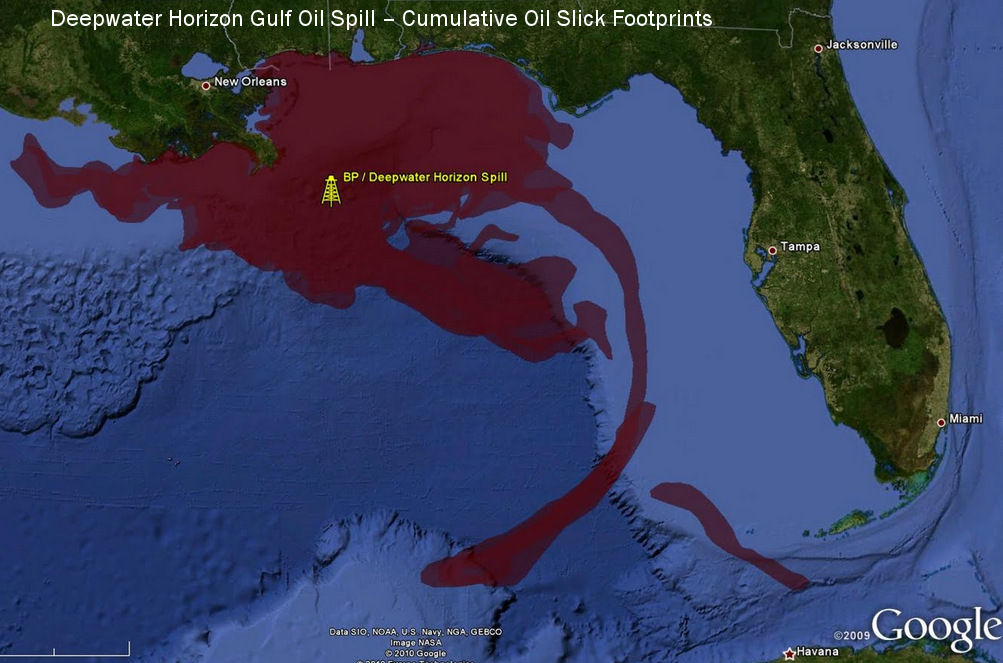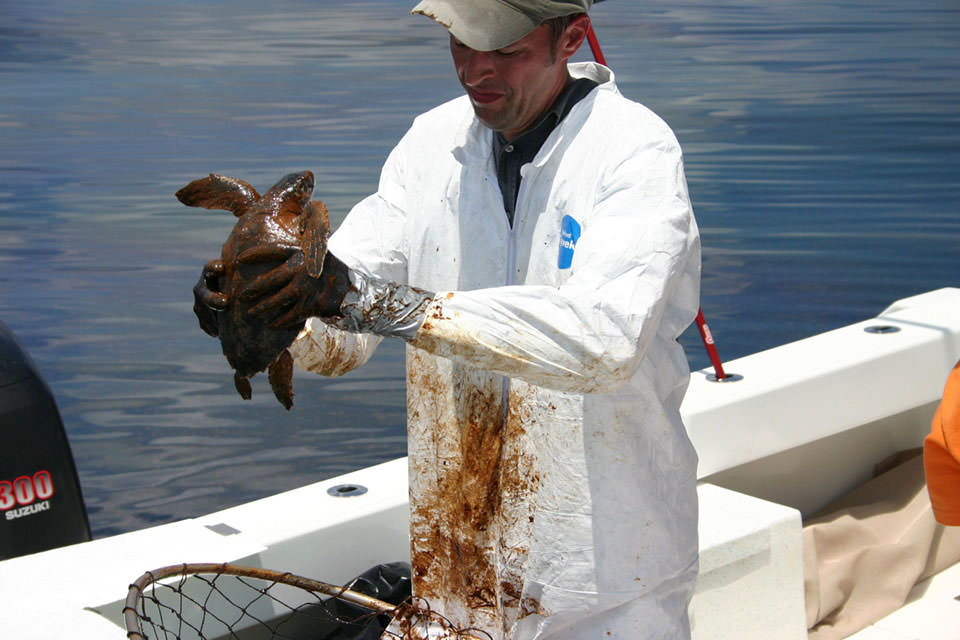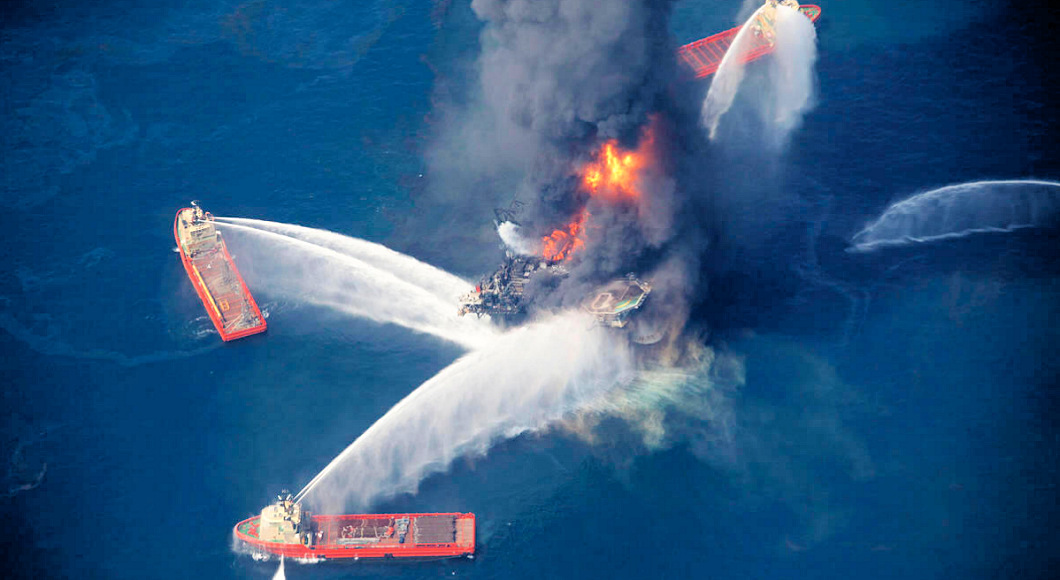On April 20th 2010, an explosion on the Deepwater Horizon oil rig in the Gulf of Mexico cause the largest marine oil spill in history.
This came to be known as the Deepwater Horizon Oil Spill, or the Gulf of Mexico Oil Spill of 2010, and years later it is still having a large impact on the environment, the ocean life, the people of the gulf region and government policy.
What Was the Deepwater Horizon rig?
Deepwater Horizon was an ultra-deepwater, dynamically positioned, semi-submersible offshore drilling oil-rig. The rig was owned and operated by an offshore-oil-drilling company called Transocean, who leased it to the BP oil company.
Where was it located?
The rig was located in the Gulf of Mexico, approximately 41 miles (66 kilometers) from the coast of Louisiana. The rig was positioned over an oil well almost 5,000 feet (1,530 meters) below the surface.
What happened?
A surge of highly flammable natural gas blasted through a concrete core that had recently been installed by a contractor company, Halliburton. The gas traveled up the rig's riser to the platform where it ignited, causing a massive explosion.
The rig capsized and sank two days later, on April 22nd 2010, rupturing the riser. Oil immediately began to discharge into the waters of the Gulf of Mexico at a rapid rate.
BP attempted to activate a fail-safe mechanism called a blowout preventer (BOP) which was designed to close the channel through which oil was drawn, but this malfunctioned because the pipe had bent under the pressure of the rising oil and gas (1).
In 2011, the US government concluded that the causes of the explosion were:
- Defective cement on the borehole
- The failure of two valves, a gas alarm, and battery backup systems
- Misinterpretation of pressure tests
- Insufficient management and industry oversight
Was anybody hurt?
Tragically, 11 workers were killed and 17 others injured in the accident.
How bad was the oil spill?
While originally estimated by BP to be about 1,000 barrels of oil per day, it was later estimated by US Government officials to have peaked at more than 60,000 per day. The oil formed a slick that extended over thousands of square miles of the Gulf of Mexico.

The oil began to contaminate the beaches of nearby Louisiana in May 2010, and by June oil slicks and tar-balls had reached the beaches of Alabama, Mississippi and Florida. It is estimated that a total of 1,100 miles (1,770km) of coastal land was polluted.
It is estimated that around 5 million barrels of oil had leaked into the gulf, of which only about 800,000 had been captured.
The Clean Up
 Cleaning up a leak of this scale required a range of different approaches.
Cleaning up a leak of this scale required a range of different approaches.
- 1.8 million gallons (6.9 million liters) of dispersants were used to help clean oil from the open water. These are substances that emulsify the oil which makes it easier for bacteria to metabolize it
- Portions of the slick were corralled off by booms, and then the oil on the surface was either burned or siphoned off
- Oil contamination on beaches was manually removed
- The state's marshes and estuaries were manually cleaned, although this was not able to bring these more delicate ecosystems back to their former condition.
Who did the Clean Up?
The cleanup efforts were coordinated by the National Response Team, which is a group of government agencies headed by the Environmental Protection Agency (EPA) and the U.S. Coast Guard.
How long did the clean up take?
Several years. After starting soon after the April 2010 accident, the Coast guard clean up efforts finished in Mississippi, Florida and Alabama in June 2013. In Louisiana the Coast Guard clean up patrols finished in April 2014.
How much did the Clean Up cost?
The clean up efforts cost billions of dollars, for which BP, Transocean, and several other companies were held liable for the billions of dollars in costs accrued.
In addition, research studies of the impact on the environment and gulf ecosystem formed the basis of the natural resources damage assessment settlement with BP for up to $8.8 billion for restoration projects.
Environmental Impact
The impact on sea and animal life was tragic and long lasting.
According to the US Government Ocean Service, scientists concluded that the Deepwater Horizon oil spill killed thousands of marine mammals and sea turtles, and contaminated their habitats (2).
 NOAA veterinarian Dr. Brian Stacy preparing to clean a Kemp's Ridley turtle.
NOAA veterinarian Dr. Brian Stacy preparing to clean a Kemp's Ridley turtle.
Thousands of mammals, birds and sea turtles were covered with oil.
Birds are particularly affected by oil spills, and according to a 2014 study up to 800,000 birds were thought to have died.
By late 2012 some 1,700 turtles had been found dead, and it is estimated that up to 65,000 imperiled turtles died during 2010 alone.
1,400 wales and dolphins had been found stranded by December 2015, which represents only a small percentage of the total amount of animals affected.
Legal Action
A civil trial of the three companies involved, BP, Halliburton, and Transocean, began in 2013.
BP was found to be 67% culpable for the spill and thus grossly negligent. Transocean was held 30% liable and Halliburton 3% liable, and both companies were deemed negligent. In July 2015, a tentative settlement was reached between BP, the federal government, and the five states affected by the spill, with BP estimating that it would cost the company $18.7 billion. A finalized settlement of $20.8 billion was announced in October 2015; this was the largest financial penalty ever leveled by the U.S. government against a single company.
The Restore Act
The Restore Act of 2012 set aside 80% of the BP oil spill settlement funds for Gulf states ecological and economic recovery. The remaining 20% of funds went to the Oil Spill Liability Trust Fund, which assists in the removal and assessment of damage from oil-related activities.
Policy Impacts
The Department of the Interior has proposed mandatory standards for oil well infrastructure and more frequent monitoring and repairs of equipment.
Extensive revisions have been made to offshore-drilling regulations following this disaster. The new regulations were issued in April 2016, and it is hoped that these will mitigate the likelihood of future disasters.
It is worth noting however that some of these regulations have met resistance from the US Oil industry (3), and that in fact Gulf of Mexico oil production hit a record high in 2016 and is expected to increase again (4).

Sources & Citations
This Energyboom article contains information and quotations from a variety of sources, including the following:- https://www.popularmechanics.com/science/energy/a6065/how-the-bp-oil-rig-blowout-happened/
- https://oceanservice.noaa.gov/news/apr17/dwh-protected-species.html
- https://www.theguardian.com/environment/2016/apr/14/new-us-oil-drilling-regulations-deepwater-horizon-disaster
- https://www.forbes.com/sites/ucenergy/2021/04/17/seven-years-after-deepwater-horizon-industry-has-flourished-amid-tighter-regulation/#601982d828b6
- https://www.britannica.com/event/Deepwater-Horizon-oil-spill-of-2010
- Graph Source: Baker Hughes.
- Graph Source: Analysis based on data from the Department of Industry and BSEE








